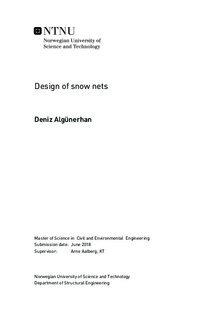Design of snow nets
Master thesis
Permanent lenke
http://hdl.handle.net/11250/2571888Utgivelsesdato
2018Metadata
Vis full innførselSamlinger
Sammendrag
The need for protection against snow avalanches has led to the development of different protection methods. One type of protection aims to stabilize the snowpack to prevent failure and thus the resulting avalanche. This protection method uses supporting structures. Which consist of steel rigid barriers or wire-rope nets. Calculating the distribution of forces in the net type after the structure is being subjected to snow pressure is complicated. The structure is flexible, and the force distribution depends heavily on the strained geometrical shape of the net.
With development of the digital computer, finding the structural response can be done with various methods. Numerical software based on cable mechanics has been developed to obtain this. Another strategy consists of using the discrete element method. This method is well adapted to describe the behaviour of granular materials like snow, and to simulate large displacements. A coupled mechanical analysis is obtained using the method, which makes modelling of the snow and net behaviour in the same program possible. Use of the finite element method is another possible strategy to model the snow nets. The method is leading in computer-oriented mechanics. With the use of commercial software, the structure can be modelled and internal forces can be found. The method is a powerful tool, but as most tools it must be properly used.
In this thesis, an example structure of a snow net is created. The structure is modelled in Dynamo using visual programming, and FE-analysis is run in Robot. Obtained results are compared with an easy method based on a simplified two-dimensional static. It is also compared with field experiments in France, Austria and Iceland.
